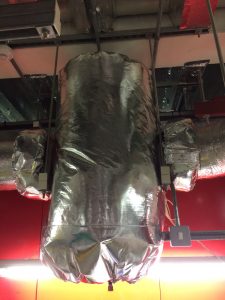Unwanted heat loss costs money!!!
The use of insulation on pipes carrying high temperature streams is a normal and accepted practice.
It should not be assumed that any existing insulation provides the most effective arrangement for avoidable cost reduction. Interestingly, in many cases, thicker insulating layers would be well justified.
All hot surfaces lose heat and, as shown in Fig 1, attention should be given to valves, flanges, etc., which are often left uninsulated for maintenance reasons. An unnsulated valve loses about the same amount of heat as 1 m of uninsulated pipe of the same diameter.
A 50 mm valve carrying process steam at 200°C would cost about €100 per annum without insulation, but only about €6 per annum with appropriate insulation. The operation of valves need not be affected by insulation and it can be applied in easily removable sections to ease maintenance.
An important consideration and additional benefit is a more uniform metal temperature with a consequent reduction in temperature induced stresses in the pipework system, which can be a cause of leakage at joints.
For a given pipe and process conditions, the rate of dissipation is dependent on the thickness of the insulating layer and its thermal performance. In most cases, the most important aspect of the insulation’s thermal performance is thermal conductivity, a physical property which relates the rate at which heat is conducted through a material to the temperature difference across the conduction path.
For the same thickness of insulation, heat losses are reduced as the thermal conductivity reduces. Radiation losses can be reduced by the addition of a shiny metallic skin to the insulating layer. The benefits of such an addition depend on actual conditions, but a 10% reduction in overall heat loss would not be untypical.

Foil Finish Air & Dirt Separator installed by GEM
Manufacturers of removable insulation jackets normally provide information on thermal performance which avoids the need for complex heat transfer calculations. The data, which are normally referred to as ‘U’ values, give the heat loss per unit length of pipe for a range of pipe diameters, process stream temperatures and insulation thicknesses
To determine the annual cost of heat loss per metre run of pipe the following information is required …
Data requirements:
- The cost of fuel (In the normal units of purchase, e.g. cent/kWh)
- The boiler efficiency (%)
- Annual operating period (hours)
- Heat loss per metre run of pipe (Watts/metre)
- Pipe size
- Operating temperature
- Type and thickness of insulation
- Ambient conditions
For more information on our heat loss and pay back calculations contact us at
info@gem.ie
M: 087 7974359
Recent Comments